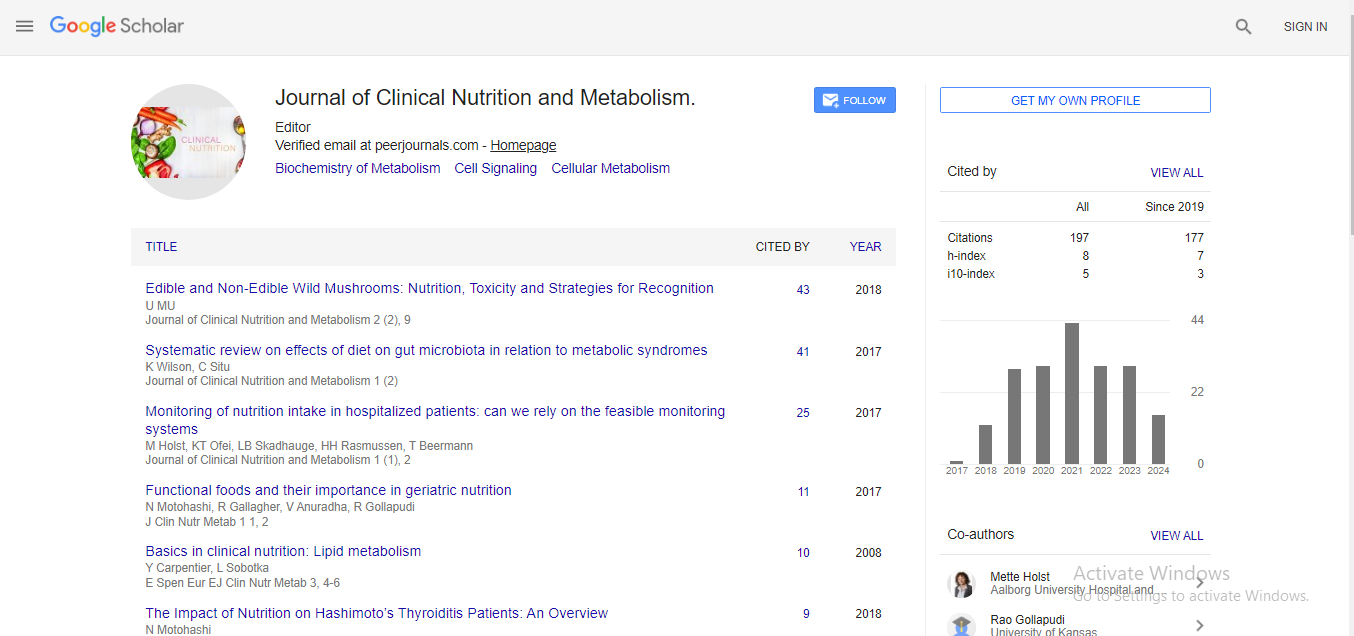Perspective, J Clin Nutr Metab Vol: 8 Issue: 4
Biological Signals in Action: Intuition into Cellular Processes and Therapeutic Advances
Thompson Ebiad*
1Department of Zoology, King Saud University, Riyadh, Saudi Arabia
*Corresponding Author: Thompson Ebiad,
Department of Zoology, King Saud
University, Riyadh, Saudi Arabia
E-mail: son_thombia@yahoo.com
Received date: 26 November, 2024, Manuscript No. JCNM-24-154791;
Editor assigned date: 28 November, 2024, PreQC No. JCNM-24-154791 (PQ);
Reviewed date: 12 December, 2024, QC No. JCNM-24-154791;
Revised date: 19 December, 2024, Manuscript No. JCNM-24-154791 (R);
Published date: 27 December, 2024, DOI: 10.35841/JCNM.1000163
Citation: Ebiad T (2024) Biological Signals in Action: Intuition into Cellular Processes and Therapeutic Advances. J Clin Nutr Metab 8:4.
Description
Cell signalling is the detailed communication system that control cellular processes and coordinates responses across an organism. It is the foundation for life’s complexity, enabling cells to perceive and respond to their environment, communicate with one another and regulate major functions. From embryonic development and immune responses to tissue repair and disease progression, cell signalling is integral to understanding biology. In this the mechanisms, pathways, significance and implications of cell signalling in health and disease.
Cell signalling refers to the process by which cells detect and respond to external or internal signals. These signals, often in the form of molecules or physical stimuli, trigger a cascade of biochemical reactions that influence cellular behavior. Basic Components of Cell Signalling, Signal molecules such as hormones, neurotransmitters, or growth factors that initiate signalling. Receptors proteins on the cell surface or within the cell that bind to ligands and initiate the signalling flow. Signalling pathways a series of molecular interactions that transmit the signal from the receptor to target molecules. Effector proteins execute the response, such as altering gene expression, enzyme activity, or cell behavior.
Cell signaling is a highly regulated process involving multiple steps, from signal recognition to cellular response. Signal reception begins with the binding of a ligand to its receptor. Receptors are broadly classified as, Cell-Surface receptors located on the plasma membrane, these receptors bind hydrophilic ligands that cannot cross the membrane. Examples include G-Protein-Coupled Receptors (GPCRs) and Receptor Tyrosine Kinases (RTKs). Intracellular receptors found within the cytoplasm or nucleus, these receptors bind hydrophobic ligands, such as steroid hormones, that can diffuse through the membrane.
Several key pathways plays important role in cellular communication and are conserved across species. G-Protein-Coupled Receptor (GPCR) Pathway is the largest family of receptors a mediate diverse responses, including vision, smell and immune responses. Ligand binding activates a G-protein, which in turn modulates downstream effectors like adenylyl cyclase or phospholipase C. Receptor Tyrosine Kinase (RTK) Pathway such as the insulin receptor, are activated by ligand-induced dimerization. This triggers autophosphorylation and selection of adaptor proteins that initiate signaling flow like the MAPK/ERK pathway.
Signalling networks enable the immune system to detect pathogens, coordinate defence mechanisms and resolve inflammation. Signals from growth factors and cytokines promote wound healing, cell proliferation and tissue remodeling. Synaptic signalling underlies neural connectivity and brain function, influencing learning, memory and behavior. Cellular responses to stress, such as oxidative damage or nutrient loss, are mediated by signalling pathways that restore balance or initiate protective measures. Deviations in cell signalling are implicated in numerous diseases, making these pathways major targets for therapeutic interventions. Mutations in signalling molecules, such as growth factor receptors or downstream effectors, lead to uncontrolled cell proliferation.
Insulin signalling defects impair glucose uptake and metabolism, contributing to type 2 diabetes. Dysregulation of mTOR signalling is associated with obesity and metabolic syndromes. Impaired signalling in pathways like Wnt or Notch contributes to the pathology of Alzheimer’s and Parkinson’s diseases. Hyperactivation of NF-B signalling results in chronic inflammation, contributing to autoimmune diseases and inflammatory conditions. Many pathogens manipulate host signalling pathways to evade immune detection or enhance their replication.
The study of cell signalling has advanced significantly, driven by innovations in technology and molecular biology. Automated platforms enable the identification of drugs targeting specific signalling pathways, accelerating drug discovery. Techniques like single-cell RNA sequencing provide insights into signalling heterogeneity within tissues. CRISPR and Gene Editing Tools like CRISPR allow precise manipulation of signalling components, facilitating functional studies and therapeutic development. Structural biology advances in cryo-electron microscopy have revealed detailed structures of signalling proteins, aiding in drug design. Engineering synthetic signalling circuits enables researchers to mimic or modify natural signalling processes for therapeutic or biotechnological applications.
Conclusion
Cell signalling is the language through which cells communicate, adapt and thrive. Its networks are major for maintaining life and ensuring proper function across biological systems. Disruptions in these pathways can lead to disease, but they also present opportunities for therapeutic intervention. The study of cell signalling not only illuminates the fundamental processes of life but also holds the potential to revolutionize medicine and biotechnology.
 Spanish
Spanish  Chinese
Chinese  Russian
Russian  German
German  French
French  Japanese
Japanese  Portuguese
Portuguese  Hindi
Hindi 